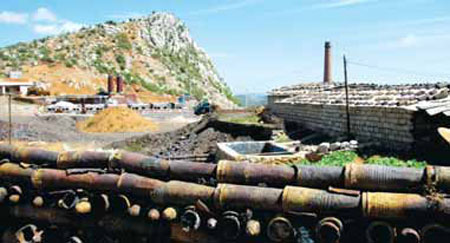| Mar 11, 2013 |
China to address mercury pollution
|
|
(Nanowerk News) To address mercury pollution, an issue that has largely been overlooked in the country, China's environmental authorities are conducting a series of technology assessments and submitting proposals for policy solutions.
|
|
The Foreign Economic Cooperation Office of the Ministry of Environmental Protection is assessing pollution control, products containing mercury and the restoration of polluted sites.
|
|
The plans are a major component of a project started in 2006 called SINOMER, the first international partnership aimed at controlling mercury in China. Tsinghua University, the Institute of Geochemistry of the Chinese Academy of Sciences, Chinese Research Academy of Environmental Sciences and Chinese Academy of Environmental Planning of Ministry of Environmental Protection are the main partners in the project.
|
 |
| Pictured here is a mercury mine in Wanshan, which has a long history of mining the heavy metal. Local officials have introduced measures to reduce the impact of pollution.
|
|
Data from the United Nations Environment Program shows mercury pollution has significant impacts on human health and the ecosystem.
|
|
"The discharge of mercury into water will harm the local environment, while emissions in the air may have regional and even global influence through long-range transport in the atmosphere and deposition in remote areas," said a team member of the SINOMER project.
|
|
"Mercury emissions in the air tends to flow from low to high-latitude regions, so we need joint effort from across the world to deal with it," he explained.
|
|
The first phase of the project - SINOMER I, completed in 2009 - was a case study in Guizhou, a Southwest China province known for its abundant reserves of mercury, its long history in exploitation of the heavy metal and pollution that resulted.
|
|
SINOMER I found serious mercury pollution in the Wanshan mercury mining area of Guizhou. The largest center of mercury mining in China, it was selected as the best choice for a pilot test zone in mercury pollution remediation.
|
|
The local government has already begun cleanup of mercury-contaminated sites in the area, but the methods are not efficient enough to reduce the overall environmental impact, according to recent research.
|
|
Based on the data collected in SINOMER I, a second phase will first evaluate the efficiency remediation measures used by the local government, and then choose a typical field for further study of remediation methods.
|
|
The technology assessment will focus on coal combustion, zinc smelting, restoration of mercury mining sites and industrial use of mercury.
|
|
Experts say coal combustion is the dominant mercury emission source in China, and expect it will continue growing along with the country's rapid economic development.
|
|
Smelting of non-ferrous metals, such as zinc, is another major source of mercury emissions. But more than 60 percent of the zinc production in China is centralized in just a few dozen large-scale enterprises, so that will be an advantage in pollution control, the team member said.
|
|
SINOMER II will evaluate the flow of mercury during coal combustion and zinc smelting, assess the efficiency of mercury removal in the existing pollution control devices and analyze the cost-benefit ratios in technologies that remove mercury.
|
|
Based on experiences in China and other countries, scientists will propose control strategies. "With improvements in our understanding and capacity, more effective mercury control technologies are likely," he said.
|
|
China is one of the world's major mercury producers with an output of 1,203 tons in the first 11 months last year. A large amount of mercury is processed to manufacture catalysts, or directly used in the production of batteries, fluorescent tubes and medical devices such as thermometers and blood pressure instruments.
|
|
He called for "stronger efforts" to reduce the use of mercury in industry. "A better overview of the production and use of mercury is needed to find the most efficient measures," he said. "We also need alternatives for industries."
|
|
SINOMER II also hosts an international mercury pollution control workshop each year, inviting scientists for companies and government agencies to enhance cooperation on control technologies and policies. The first workshop was held in November 2010.
|

